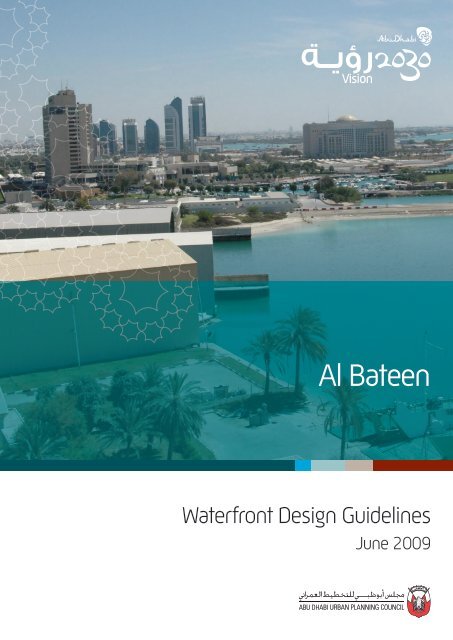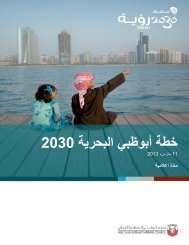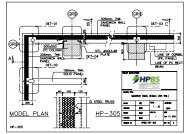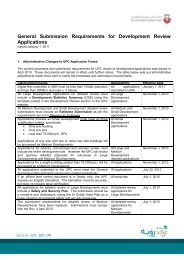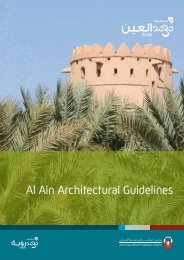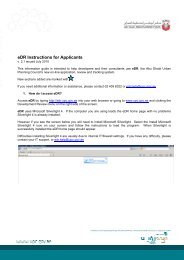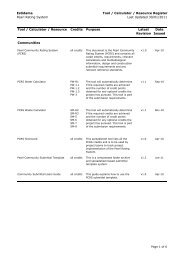Al Bateen Waterfront Design Guidelines
Al Bateen Waterfront Design Guidelines
Al Bateen Waterfront Design Guidelines
- No tags were found...
You also want an ePaper? Increase the reach of your titles
YUMPU automatically turns print PDFs into web optimized ePapers that Google loves.
<strong>Al</strong> <strong>Bateen</strong> <strong>Waterfront</strong> <strong>Design</strong> <strong>Guidelines</strong>OverviewThe key principles supporting the <strong>Bateen</strong> <strong>Waterfront</strong> <strong>Design</strong> <strong>Guidelines</strong>are:The ‘City will be structured to provide public access to the waters edge,the island environment and the desert’ (pp 39, Plan Abu Dhabi 2030)‘Because all trips begin and end with a walk, walking should be made ascomfortable as possible all year round in Abu Dhabi’Innovative ways will be developed to shade and cool the public realm inAbu Dhabi’s summer climate’ObjectivesThe purpose of the <strong>Bateen</strong> <strong>Waterfront</strong> <strong>Design</strong> <strong>Guidelines</strong> is to provideall property owners and developers along the <strong>Bateen</strong> waterfront with aframework to contribute to the achievement of these goals, through thededication of land for the design of community access and amenitiesalong the entire waterfront. Underlying these goals is the aspirationembodied in PLAN ABU DHABI 2030 to reflect in Abu Dhabi’s environmentthe highest standards of design excellence befitting a world class capitalcity.The following are the main principles to be realized in the implementationof the <strong>Bateen</strong> <strong>Waterfront</strong> <strong>Design</strong> <strong>Guidelines</strong>:• Preserve public connectivity from the waterfront to the primary publicaccess routes of the city• Preserve views from public access-ways to the water’s edge.• Provide continuous open public access at the water’s edge for peopleof all ages and abilities.• Provide strategic focal points at the water’s edge that offeropportunities to celebrate culture, heritage, and views.5
<strong>Al</strong> <strong>Bateen</strong> <strong>Waterfront</strong> <strong>Design</strong> <strong>Guidelines</strong>Water 2 Water ConnectionAbu Dhabi will respect, be scaled to, and shaped by the naturalenvironment of sensitive coastal areas and to reinforce its strategiclocation as an island city. Water is a very important element to any city,and Abu Dhabi willThe <strong>Bateen</strong> waterfront has a special place in the history and developmentof Abu Dhabi as a waterfront location. Water 2 Water Connections willensure that this is connected to existing and future proposed publicwaterfront areas such as the Corniche and east side of the city (as shownabove).<strong>Al</strong> <strong>Bateen</strong> <strong>Waterfront</strong>8
<strong>Al</strong> <strong>Bateen</strong> <strong>Waterfront</strong> <strong>Design</strong> <strong>Guidelines</strong>A. View Corridors & ConnectionsB. <strong>Bateen</strong> <strong>Waterfront</strong> PromenadeC. Special Public Places & ViewsD. Corniche Water to Water Connection10
<strong>Al</strong> <strong>Bateen</strong> <strong>Waterfront</strong> <strong>Design</strong> <strong>Guidelines</strong>A. View Corridors & Connectors <strong>Waterfront</strong>The waterfront is to be connected physically and visually to thecirculation routes of the city. Primary pedestrian connectionsperpendicular to the waterfront and linking Bainunah Boulevard and thesurrounding neighborhoods will be identified in the <strong>Bateen</strong> <strong>Waterfront</strong>Framework Plan and preserved for public use.These identified routes will provide minimum corridor widths free ofbuilt vertical and horizontal constructions to maintain unobstructed andsweeping views to open water. These routes will integrate landscaping,pedestrian scaled lighting, public art and street furniture, way-findingtools and multi-modal transportation uses including light-rail, automobileand bicycle facilities.11
<strong>Al</strong> <strong>Bateen</strong> <strong>Waterfront</strong> <strong>Design</strong> <strong>Guidelines</strong>B. <strong>Bateen</strong> <strong>Waterfront</strong> PromenadeThe Promenade shall provide the <strong>Bateen</strong> Area with a unique identityand focus. Utilizing the unique harbor setting of old <strong>Bateen</strong>, thisunique waterfront promenade will showcase a collective patchworkof developments by creating a new relationship between the City andthe Arabian Gulf. This will become a destination which is not only wellconnected with future public transit options, but will also be a placewhere all members of the community can walk or bike, enjoy thescenic beauty and relate to the cultural importance of the Arabian Gulfto the history of Abu Dhabi. Additionally, the community shall havethe opportunity to participate in diverse retail, cultural as well as noncommercialactivities while capitalising on the tourism market.The <strong>Bateen</strong> <strong>Waterfront</strong> Area will provide a continuous connectedwaterfront spanning a few kilometers in length, with a generouspromenade at the water’s edge for open public access at all hours of theday, week and times of the year. The promenade shall be typically 10 -12 meters in width and can accommodate the following activities:• Dedicated pedestrian path (6 metres minimum)• Dedicated cycle path (3 metres typical)• Cafes, outdoor seating (4 metres suggested)• Dedicated public seating areas (1.5 metres)• Wayfinding lighting and signage• Landscaping and green areas• Multiple transportation choices as alternatives to the automobile(transit, ferries, water taxis, bus service, shuttle golf buggies, bicyclepark and ride)12
<strong>Al</strong> <strong>Bateen</strong> <strong>Waterfront</strong> <strong>Design</strong> <strong>Guidelines</strong><strong>Waterfront</strong> typologiesHorizontal PlaneThese examples show how the waterfront can be divided into apedestrian, seating / landscaping, cycle, privacy screening and seatingareas.13
<strong>Al</strong> <strong>Bateen</strong> <strong>Waterfront</strong> <strong>Design</strong> <strong>Guidelines</strong>Grade SeparationAreas can be separated over various topographic levels which give depthand interest to the area, while providing opportunity to enhance views.14
<strong>Al</strong> <strong>Bateen</strong> <strong>Waterfront</strong> <strong>Design</strong> <strong>Guidelines</strong>Privacy SensitivePrivate outdoor areas can be elevated alongside completely public spacesusing elevations and landscaping elements to obscure views.15
<strong>Al</strong> <strong>Bateen</strong> <strong>Waterfront</strong> <strong>Design</strong> <strong>Guidelines</strong>Beach TreatmentMany hotel developments have private beach fronts. Structural elementsmay be placed along the waterfront to allow public / private areas to coexist& enhance the amenity of the area.16
<strong>Al</strong> <strong>Bateen</strong> <strong>Waterfront</strong> <strong>Design</strong> <strong>Guidelines</strong>Examples: SingaporeSingapore River has many good examples of landscaping, lighting, &interactive waterfront terraces for pedestrians. Shading is abundant toprotect pedestrians from the weather.18
<strong>Al</strong> <strong>Bateen</strong> <strong>Waterfront</strong> <strong>Design</strong> <strong>Guidelines</strong>Examples: AdelaideGlenelg, beach side suburb of Adelaide uses active shop fronts & goodurban design to activate marina front walkways. Beach access is publicand accessible and non-privatized.19
<strong>Al</strong> <strong>Bateen</strong> <strong>Waterfront</strong> <strong>Design</strong> <strong>Guidelines</strong>Bike & Water TaxiMoreover, the <strong>Bateen</strong> <strong>Waterfront</strong> will introduce an innovative, first everimplemented integrated system of bicycle and water taxi network in AbuDhabi. It is intended that with the success of this system, it will graduallyevolve throughout the rest of the city along the Corniche and along otherprimary roads, open spaces, pedestrian networks and other waterfrontpublic places.Every major development (hotel, residential, retail, office, etc) have atleast one:• Bicycle ‘park and ride’ facility; and• Water taxi drop off point (if possible)This bicycle and water taxi system should form a functional and efficientnetwork measured by the total number of person trips per development(will vary on scale and size of each project and the demands thereof).The location of the bicycle storage unit will need to be accessible to thepublic and will need to accommodate up to 100 bicycles, however; thisnumber may be somewhat larger or smaller depending on the size andscale of development.Likewise, a water taxi drop off point will be mandatory for somedevelopments while for other smaller scale projects and sites, it will notbe deemed necessary.20
<strong>Al</strong> <strong>Bateen</strong> <strong>Waterfront</strong> <strong>Design</strong> <strong>Guidelines</strong>Promenade <strong>Design</strong> StandardsIt is understood that a 10 – 12 metre wide promenade may not beachievable in every instance along the stretch of waterfront; however, aminimum 6 meter pedestrian and 3 meter cycle path shall be maintainedthroughout.The Promenade shall be a response to the climate and reflect the heritageof Abu Dhabi. This can be achieved through incorporating the followingelements in the design of the Promenade:• Incorporation of Arabic/Abu Dhabi heritage and artistic elements• Incorporation of sustainability practices i.e. water-wise plants,recycled water for irrigation and ‘green’ materials• The use of low reflection / energy use or solar lighting alongPromenade• Provision of adequate shade and respite from the harsh summerclimate in the form of physical structures and appropriate landscaping• The use of durable, natural and permanent materials that reflect themarine climate and Dhow fishing village environment• Ends of the promenade designed to ensure connections to all adjacentproperties and developments including to public roads and otheraccessible spaces21
<strong>Al</strong> <strong>Bateen</strong> <strong>Waterfront</strong> <strong>Design</strong> <strong>Guidelines</strong>Promenade Details<strong>Al</strong>l elements composing the promenade shall be constructed accordingto the 2006 International Building Code and the Estidama Green Building<strong>Guidelines</strong>. As already outlined, the connecting ends and edges of thewaterfront promenade will be coordinated by the property owner with alladjacent properties to provide a continuous and uninterrupted visual andphysical infrastructure. UPC is looking for cognitive thinking to encourageeach property owner to contribute symbolic yet sympathetic forms ofpublic art work along the Promenade.It should be made clear that the initial cost of the promenade includingthe ongoing maintenance and upkeep will be the responsibility of theindividual property owner.Seating areas and other structures or fixtures can be strategically placedwithin the promenade (such as within landscaping or green areas)however, this shall not obstruct the dedicated pedestrian / bicycle accessalong the promenade.22
<strong>Al</strong> <strong>Bateen</strong> <strong>Waterfront</strong> <strong>Design</strong> <strong>Guidelines</strong>Promenade <strong>Design</strong> StandardsViews to and from the promenade shall be protectedThese views are aprominent feature/attraction of the promenade and they will be protectedand enhanced through the construction of shaded viewing platforms adjoiningthe Promenade at distinct locations within each development. Theviewing platforms shall provide at a minimum seating, information boardsand interpretative facilities at viewing points, relating to various points ofinterest.Where it is not possible to provide a land promenade at the water’s edge,the land owner may be asked to design and construct an over-the-waterboardwalk. Promenades at the rear of sites away from the water’s edgeare not recommended. In all cases it is recommended that each propertyowner provide a 4 meter minimum sidewalk / emergency vehicular routecompletely around the plot boundary as a continuous link to the promenadeand public sidewalks.In addition, the minimum 6 meter wide public promenade shall connectand provide continuous and complete pedestrian access to adjacent developmentsand the existing urban grid and neighbourhoods of the area.In no cases will pedestrian or bicycle access ways dead-end, and plansmust reflect connections beyond the boundaries of the individual site.The connecting ends and edges of all connecting sidewalks will be coordinatedby the property owner with all adjacent properties to provide acontinuous and uninterrupted physical infrastructure.23
<strong>Al</strong> <strong>Bateen</strong> <strong>Waterfront</strong> <strong>Design</strong> <strong>Guidelines</strong>Roads, Peds, Bikes...An integral part of the <strong>Bateen</strong> <strong>Waterfront</strong> Framework Plan is the water towater connecting corridor to the Corniche. This linear park will link thepublic amenities of the Corniche with the <strong>Bateen</strong> <strong>Waterfront</strong> providingthe community with an alternative route for recreational activities inAbu Dhabi. The 60 m wide corridor will be safeguarded from privatedevelopment and reserved for the incorporation of transit, bicycle andpedestrian ways. Public artwork, landscape and lighting elements willcelebrate this unique place in the city. The existing Zalamat Garden willcontinue to function as a community open space, and be reinvigoratedwith additional public amenities and a possible future Metro Station. TheCorniche and Bainunah intersections with the water to water corridor willbe redesigned to provide safe and convenient pedestrian crossing points.26
Bainunah Blvd<strong>Al</strong> <strong>Bateen</strong> <strong>Waterfront</strong> <strong>Design</strong> <strong>Guidelines</strong>Appendix A###Marina Mall12 mCorniche##Zayed the First#60 m12 m22 m60 m#40 m12 m22 m#12 m40 m12 mFuture Extension#80 m12 m22 m22 m22 mLegendMetro RoutesTram RoutesSpecial PlacesView ConesView CorridorsRoad EdgesPlots<strong>Waterfront</strong> PromenadePedestrian Cycle<strong>Al</strong>ternative RoutesWaterwayMetro StationTram StationAppendix A: <strong>Al</strong> <strong>Bateen</strong> <strong>Waterfront</strong> Framework PlanScale: 1:3,0001250 250 500Meters®Date: 31.05.200922 m27
مجلس أبوظبي للتخطيط العمرانيص.ب 62221أبوظبي، اإلمارات العربية المتحدةFor further information please contact:Mr Kosta LivaditisTel: +971 2 409 6000Fax: +971 2 443 2903www.upc.gov.aeAbu Dhabi Urban Planning CouncilP.O.Box 62221Abu Dhabi, United Arab Emirates


